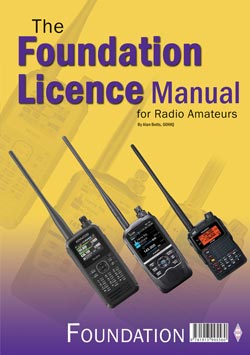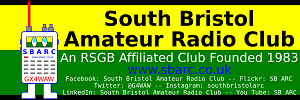
Getting Started in Amateur Radio: The Foundation Licence
The Foundation licence is your gateway to amateur radio. The course and exam that leads to the licence provides you with an exciting introduction to the hobby while requiring an acceptable minimum level of skill and experience.
Your Foundation licence is recognised by the UK communications regulator Ofcom, and entitles you to take a unique identifier called a callsign which will be used to identify you when you are transmitting.
Studying for your Foundation Licence
The table below contains links to printable versions of the course notes prepared by the South Bristol Amateur Radio Club.
| Topic Number | Printable Notes | Presentation Slides | Videos |
|---|---|---|---|
| Introduction | No Presentation Slides | ||
| 1 | Licensing Conditions and Station Identification | Licensing Conditions and Station Identification | |
| 2 | Technical Aspects | Technical Aspects Part 1 Technical Aspects Part 2 Technical Aspects Part 3 |
|
| 3 | Transmitters and Receivers | Transmitters and Receivers | |
| 4 | Feeders and Antennas | Feeders and Antennas | |
| 5 | Propagation | Propagation | |
| 6 | Electromagnetic Compatibility (EMC) | Electromagnetic Compatibility (EMC) | |
| 7 | Operating Practices and Procedures | Operating Practices and Procedures | |
| 8 | Safety | Safety | |
| 9 | Measurements and Construction are not covered at the Foundation Level | ||
| 10 | Practical Assessments These have been permanently withdrawn although there is a suggestion that Practical Assessments will be reintroduced at Syllabus 2.0 in a form compatible with distance learning. These notes are provided to give context to the RSGB video series linked to in the 4th column of this table. The old Practical Assessments gave a useful demonstration of some of the points included in the theory. We encourage you to watch the RSGB videos and read the notes to accompany the old Practical Assessments to broaden your knowledge and understanding. |
No Presentation Slides | 0. Complete Video as one show 1. Setting Up Your Station 2. How to use your AMU or ATU 3. Making Your First SSB Contact 4. Adjusting Antenna Length To Obtain The Lowest SWR 5. Making Your First FM Contact 6. Using Modes Other Than Voice |
The Foundation Exam
Don’t be put off by the thought of having to do an exam. The Foundation exam is very straightforward and consists of multiple choice questions which you have to answer.
The Foundation examination is a multiple choice exam and consists of 26 multiple-choice questions each with four possible responses of which only one will be completely correct. You are permitted 60 minutes to answer the questions and the pass mark is 19/26 or 73%.
| Subject | Number of Exam Questions | Percentage of Exam Questions |
|---|---|---|
| Licensing Conditions and Station Identification | 6 | 23.08% |
| Technical Aspects | 3 | 11.54% |
| Transmitters and Receivers | 3 | 11.54% |
| Feeders and Antennas | 3 | 11.54% |
| Propagation | 2 | 7.69% |
| Electromagnetic Compatibility (EMC) | 3 | 11.54% |
| Operating Practices and Procedures | 3 | 11.54% |
| Safety | 3 | 11.54% |
| Measurements and Construction | – | – |
| TOTAL | 26 | 100.01% |
Note that the Licence Conditions form the largest part of the exam with 6 questions, almost one quarter of the exam. It is therefore a good idea to try to get to grips with the Licence Conditions since if you can get to the position where you are sure of answering all 6 Licence Conditions questions correctly then you have a number of advantages:
- Firstly as the Licence Conditions questions are the first 6 questions you will give yourself a confidence boost for the rest of the exam; and
- If you are sure that you have scored 6/6 on the Licence Conditions you only have to score 13/20 on the rest of the exam which reduces the needed correct answers to 65% or roughly 2 out of 3.
What happens After the Foundation Exam?
If you have passed the Foundation exam you will receive an official result sheet confirming the pass from the RSGB.
The next step is to register your Foundation exam pass with the UK communications regulator Ofcom, who are responsible for issuing amateur radio licences. If you apply for your Foundation licence on the Ofcom website, your licence is free of charge. Visit the Ofcom website to find out more.
Once you have your Foundation licence and have chosen a callsign, you are ready to make your first transmission on the amateur radio bands; an exciting moment. You are now free to operate on the majority of the amateur bands, without supervision, up to a power of 25 watts. This does not sound like very much power, but once you have acquired experience operating your radio you will find it is enough to communicate anywhere in the world under the right conditions.
Take a look at the RSGB “Beyond Exams” pages, and particularly the “Useful Practical Skills” series of videos trailed below.
Links to the individual videos:
- Slim Jim antenna (7:10)
- Simple balun (7:49)
- Soldering a PL-259 (9:57)
- Tuning a dipole using a NanoVNA (12:28)
- Audio interface (21:12)
- CAT control (21:21)
